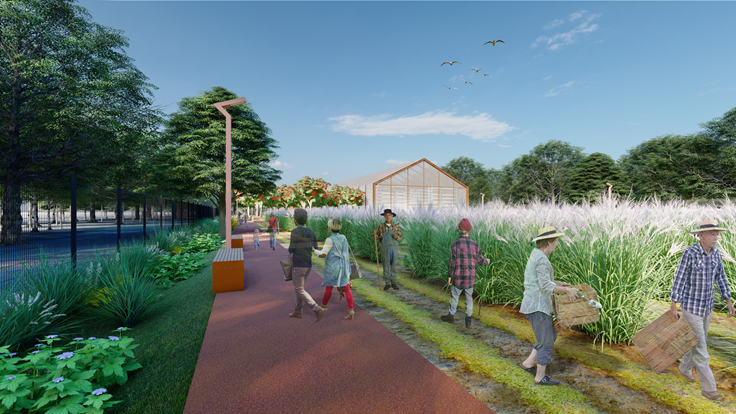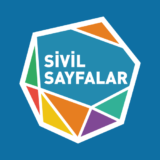Sasalı Climate Sensitive Agricultural Education and Research Institute Is Being Established

Izmir Metropolitan Municipality is establishing an education and research institute in order to inform citizens about the drought that may occur in the future due to climate change and to explain the correct methods in agriculture. We’ve listened to Izmir Metropolitan Municipality General Secretary Doctor Buğra Gökçe about Sasalı Climate Sensitive Agricultural Education and Research Institute which is a Urban GreenUP project supported by the European Union's Horizon 2020 program.
How did the idea of the project emerge?
Sasalı Climate Sensitive Agriculture Education and Research Institute is an Urban GreenUP project that started with the application of İzmir Metropolitan Municipality and supported by the European Union’s Horizon 2020 program. It is designed to collect experimental and practical data and evaluate these data with natural and sustainable methods. We can summarize the idea of emergence in the design phase of the project as follows:
Deformations in the natural environment shaped by humans transform today’s living conditions, and therefore it becomes an imperative to develop new arrangements and techniques such as nutrition and shelter for vital activities that can adapt to these transformations. Undoubtedly, the negative and positive effects of technological developments on this need which started to appear on a global scale are quite high. At this point, perhaps it will not be wrong to compare technology to two faced medallion. Although it is clearly seen that the rapid technological developments experienced especially after the 2000s have negatively affected the natural environment, it is obvious that today, still solutions are sought to this problem through technology. For this reason, the issue of how the deformation of natural environment that’s global dimensions are increasing day by da will affect the life in the world is subject to many studies today. These studies are expected to produce alternative solutions to environmental problems such as global warming, climate changes and drought as well as the decrease of soil quality.
In this context, when it is examined in Turkey scale, the increasing population due to foreign migration and the need for shelter in parallel to this cause the built environmental areas to increase especially in recent years. This situation endangers agricultural areas among the urban areas in recent years. Since the narrowing urban centers cannot respond to the increasing population, the built environment phenomenon that spreads towards the city wall transforms the agricultural areas. In addition, 21st century daily life, changing living standards and agriculture and livestock policies put into practice push people in rural areas to migrate to the city. The fact that the number of people engaged in agriculture or animal husbandry tends to decrease across the country shows that there will be serious problems regarding both activities in the future. When the problem of reduction in natural resources caused by environmental deformations is added to this decrease trend, the size of the problem will be understood more clearly.
The problem of global warming and drought which affects the whole World especially in recent years, threatens the sustainability of life on the planet. Within this scope, projects that can adapt to the threats that may occur in the future and that will be based on the continuity of life will be produced with the measures and practices to be taken on a global (macro) and local (micro) scale. Sasalı Climate Sensitive Agricultural Education and Research Institute in İzmir also stands out as an exemplary application for these projects. The project, which was prepared based on the drought prediction that is thought to be occurred in İzmir in 2080, is the product of an experimental study that will serve the drought situation.
What phases are among the project stages?
The physical environment of the project area for a 100-year period was examined. Urbanization activities were gradually observed around the project area, which was located in the rural landscape until the 1970s. With the construction of Sasalı Natural Life Park in 2008, the project area was surrounded and gained its identity today. Within the scope of European Union’s Urban GreenUP Program, the workspace was designed in 2019 in cooperation with academia-local government-contractors. Since 80% of the world’s population will live in urban areas until 2050, the re-naturalization of urbanization is targeted in this process.
According to IPCC AR4, more frequent, severe and prolonged droughts and hot air waves and short but more severe showers in South Europe including Turkey is expected in the 21st century. In this context, in order to create resistance against hydro-meteorological excesses, strategies that are sensitive to reducing the effects of climate change, to sustainable rainwater management and to dissemination of nature-based practices have been developed.
The project, which is planned to be located in the Sasalı district of Çiğli region of İzmir, was designed to be focusing on education and production. Within the scope of the project designed for this purpose, normal and smart soil applied agricultural areas, a high-row planting applied agricultural area, greenhouses, eco-market, multi-purpose hall, training classes, management, laboratory, library, technical service and wet areas were designed. The bioswale that holds the units arranged in a linear setup together and the circulation axis attached to it stand out as the backbone of the design.
Such a backbone setup offers users who will visit the site to learn by understanding and experiencing the mechanism of the institute. The entrance to the area along the north-south axis is provided from the north axis. The circulation backbone, which starts from the main entrance leads visitors / users primarily to educational places such as laboratories and libraries. The places such as greenhouses and vertical garden that will include agricultural activities are separated from each other with the eco market area created by the expanding of circulation axis. Agricultural activity areas located near the Eco market area invite users to see and experience different agricultural techniques. The design setup ends with the normal and smart soil applied agricultural areas located on the southern end of the area.
What will be done under the project? Could you give information about the alternative agricultural examples and studies that will be made with natural methods in open agricultural fields?
Within the scope of the project, experimental solutions are sought for some problems arised from wrong agriculture applications and industrialization. The first of these problems is flood risk. Surface waters are collected in infiltration ponds by being transferred to the bioswale which is designed by the detailed analysis of the elevations in the area and by being cleaned with specially selected local plants there. In case of flooding, they are transferred to the draining system below. The draining system stores water and once the flood is over and the soil is dry, it reintegrates the clean water into groundwater.
The second is the reduction of pollen insects. The landscape was chosen among local and pollen-attracting plants. Pollinator houses made of natural materials that do not contain any chemicals were constructed and a visiting point for pollinator insects was created.
The third is the soil becoming salty and agriculture becoming inefficient. For this, soilless agriculture, vertical agriculture and biochar (smart soil) applied agriculture techniques will be applied. Agriculture with high row planting practices will be done and the yield will be measured with different agriculture techniques.
Within the scope of the project, Biobulvar route will be made and people’s awareness will be raised, cooperatives will be supported, natural and permeable materials will be supported, water on the roofs will be stored and reused. Three types of greenhouses will be built, at the two of them greenhouse cultivation in various climates will be taught and a drought scenario will be shown in the other. It is planned to demonstrate that ecological solutions can be produced with active construction techniques by using reinforced concrete and steel in the structures within the scope of the project.
With this project, the targets of raising the awareness of environmental protection among the people of İzmir, including the city people to the project with education and travel methods that draw attention to the climate problems, and ensuring the active participation of local communities will directly contact İzmir residents.
Which areas of Izmir does this project cover? What does Sasalı Climate Sensitive Agricultural Education and Research Institute mean for the people of Izmir?
The project is located in the İzmir Wildlife Park in Sasalı. Its effects are expected to be reflected in İzmir over time. The fact that the project is experimental and educational is of great importance for the people of Izmir. While the educational purpose of the solutions designed by creating different techniques is important, it is aimed to raise awareness among the people. With this project, the targets of raising the awareness of environmental protection among the people of İzmir, including the city people to the project with education and travel methods that draw attention to the climate problems, and ensuring the active participation of local communities will directly contact İzmir residents.
Within the scope of applications, it is aimed to improve the planning and implementation skills for the agricultural areas while enabling the transfer of better and more accurate production to the farmers.
How will Izmir Metropolitan Municipality ensure that the project is sustainable and developable?
Sasalı Climate Sensitive Agricultural Education and Research Institute is a project supported by URBAN GreenUP and the European Union’s Horizon 2020 program. With the aim of developing, implementing and repeating city plans, it aims to reduce the effects of climate change, improve air quality, improve water management, as well as increase the sustainability of cities through innovative nature-based solutions with a group of partner cities from Europe and abroad. After the measurements to be made at the nature-based solutions in the project area and their efficiency are tested, it is aimed to become widespread throughout the city. This open air laboratory, which shows the effects of rising temperatures, irregular precipitation and soil chemistry changes on the bio-species that people in Izmir recognize from their daily lives, will be the “laboratory of the future” and will greatly affect the green consciousness of the citizens.
Citizens will be visually informed about the measures to be taken against the drought that may occur in 2080, in three greenhouses which are spread over an area of 1000 square meters where drought, soilless and vertical farming practices will be explained. Within the scope of applications, it is aimed to explain better and correct production to farmers, while the planning and implementation skills of the farmers are aimed to be developed. It is aimed that the trainings in the institute to be carried out within the framework of social agriculture and community supported agriculture practices and thus, it will appeal to a wider audience. With these special education and communication programs the future of the city which is under the negative effects of climate change will be simulated and an important educational dimension will be provided for citizens and especially for students.

Bizi Takip Edin